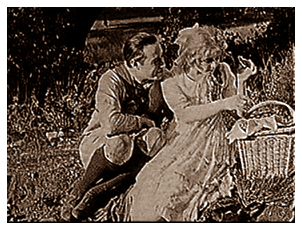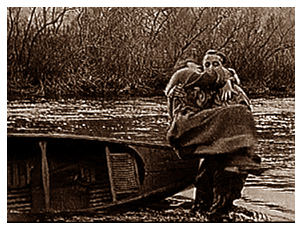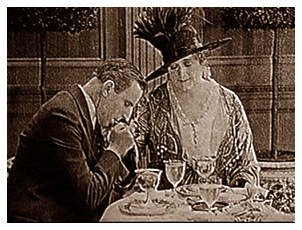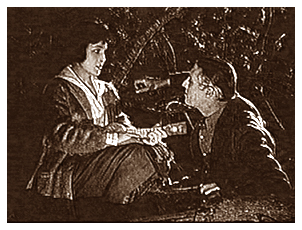

Produced by Artcraft Pictures Corp. for release by Famous
Players-Lasky Corp.
Directed by Cecil B. DeMille
Scenario by Jeanie Macpherson based on the novel by David Graham
Phillips.
CAST: Elliott Dexter (Charles Murdock), Florence Vidor (Julia
Raeburn), Sylvia Ashton (Sophy Murdock), Wanda Hawley (Sophy as
a young girl), Theodore Roberts (Berkeley), Marcia Manon (Viola),
Julia Faye (Jessie), J. Parke Jones (Charley Murdock) Helen Jerome
Eddy (Norma Murdock), Gustav von Seyffertitz (Blagden), Alice
Taafe {who later became Alice Terry} (saleslady)
Charles Murdock is a wealthy, successful oil man who, although he has older teenage children, looks much younger than his age. He is very neat and dignified. His wife, Sophy, was a beautiful, trim country girl of 18 when he first met her. She has now become an overweight, lazy woman who sits around in her nightgown all day eating chocolates and reading the comic pages of the newspaper. Murdock is not only disgusted with the fact that she has let her appearance decline, she also does not care about the cleanliness of the house nor herself. Before leaving on a hunting trip with his son and male secretary, he tells Sophy he wants a divorce. She can think about it while he's gone. On the trip, he meets Juliet, another hunter who is also camping in the rough - a very attractive, neat a proper - and very successful - dressmaker from New York. Although the relationship grows during these weeks, just prior to leaving, Murdock admits that he is married. Complications arise when he arrives home and the son happens to mention Juliet to his mother. Matters worsen when Murdock's scheming secretary allows Sophy to find Juliet's perfumed handkerchief Murdock kept from the trip.
Murdock is glad to take a trip to New York to meet his partner, Berkeley and asks his daughter is she'd like to come along. They meet Berkeley - who has his mistress with him - at a dress shop, which Murdock is surprised to find out belongs to Juliet. Although he professes his love for her, Juliet refuses to pursue the relationship because of his marriage. In a jealous rage over another woman, Berkeley's mistress shoots and kills him in his apartment. Although Murdock tries to cover up the incident as a death by heart failure, a newspaper reports that it is rumored Berkeley was shot following an argument with his business partner over a woman. Sophy is enraged when she learns of this and is convinced (mistakenly, of course) that Juliet must be the woman mentioned by the newspaper. In a spiteful rage, she calls the newspaper, tells them Juliet is the "other woman" and will be named in her divorce proceedings. Not only does it seem Murdock has lost Juliet forever, he is also the indirect cause of the loss of her good reputation. But Murdock has an idea how to correct his dilemma.
It was once commented that Cecil B. DeMille made a career out of using either sex or religion to sell his movies, sometimes even combining the two in one film. That is patently unfair as one views the overall output of this highly successful, if in some ways controversial, director. After all, he launched his career as director with the Jesse L. Lasky Feature Play Co. with westerns such as "The Squaw Man" (1914), "The Virginian" (1914), "The Girl of the Golden West" (1915) and others. His work was indeed varied during this time including a Civil War drama ("The Warrens of Virginia - 1915), dramas in foreign lands ("The Unafraid" - 1915 and "The Captive" - 1915), comedies ("Chimmie Fadden - 1915), social commentary ("The Kindling - 1915) and even bringing an opera to the silent screen ("Carmen" - 1915).
 It was DeMille's seventeenth production
(made within his first two years of directorial duties) that caused
a sensation and brought the name of DeMille to the forefront of
directors - "The Cheat" (1915). It was drama of the
most intense kind, but flavored with hints of sex and miscegenation.
It was DeMille's seventeenth production
(made within his first two years of directorial duties) that caused
a sensation and brought the name of DeMille to the forefront of
directors - "The Cheat" (1915). It was drama of the
most intense kind, but flavored with hints of sex and miscegenation.
"Old Wives for New" (1918) was another foray into that precipice of forbidden territory. One contemporary observer noted, "Accurately appraising the new civilization that was emerging, DeMille decided that the majority of theatre patrons were fundamentally curious about only money and sex." 1
Nevertheless, DeMille claimed that he was somewhat pressured to do the film. "The fact is that I made 'Old Wives for New' only after repeated urging from the New York office . . . Jesse (Lasky) sent me a memorandum signed by Carl. H. Pierce of the New York publicity department, which merits quotation: 'What the public demands today is modern stuff with plenty of clothes, rich sets, and action.' Three weeks later, Jesse resumed the theme: 'Remember that we are holding 'Old Wives for New' until you decide whether or not you want to produce it. I am strongly of the opinion that you should get away from the spectacle stuff for one or two pictures and try to do modern stories of great human interest.' So I did." He added, "The reader may, if he chooses, consider that my original sin. He may write down . . . the date on which I bade a last good-by to integrity and art."2
In spite of the professed claim of being compelled to make this film, the finished product has all the attributes of the DeMille touch. As author and silent film historian James Card observed, "If DeMille felt chastened by having to work on a story not of his own choosing, he did not tackle the assignment with any lessened vigor, nor did he put the brakes on his determination for innovation." It would appear by the making of such subsequent films as "Don't Change Your Husband" (1919), "For Better or Worse" (1919), "Male and Female" (1919), and "Why Change Your Wife" (1920) that although "Old Wives for New" was not the story of his choosing, he discovered a formula that was appealing to postwar movie-going audiences and did - by his own choosing - proceed with similar themes in his productions.
"Old Wives for New" was a popular novel by David Graham Phillips for which the Lasky Company has paid $6,500 for rights - not an unsubstantial sum for the time. Obviously, the company saw box office value in the story, and if DeMille had not taken the it on, it's safe to assume it would have been filmed by someone else in the Lasky stable - although doubtfully with the same result.
Today's silent film fans tend to think only of Elinor Glyn when the subject of risqué writings are mentioned for this period, however, others were testing the waters, as well, especially as mores, fashions and lifestyles changed somewhat dramatically in concert with the end of World War II. The popular song of the time that declared, "How 'ya gonna keep 'em down on the farm now that they've seen gay Paree?" portrayed the social implications of the Great War more accurately than is at first apparent.
"Old Wives for New" does not stand out for its originality, but it may have presented a scenario that was more true to life and personally identifiable with the audiences of the day than most other films released at the same time such as Mary Pickford's "M'Liss," D.W. Griffith's "Hearts of the World," or Douglas Fairbanks' "A Modern Musketeer." Although considered "risqué" by many at the time, it is unlikely audiences - even in 1918 - were attracted solely for the groundbreaking subject matter, but instead because the story - ever how slight - could be brought down to a personal level of the poor, middle class or rich.
The central character is Charles Murdock, extremely wealthy oil man, who is well-dressed and dignified - and whose looks belie his age. At the other extreme is his wife, Sophy - once a beautiful, trim, innocent girl when he met her at the age of 18 - but almost 20 years later, an overweight, sloppy, unkempt, slovenly woman who in no way resembles the sprightly creature he met in the country so many years before.
In later years, DeMille developed a reputation for introducing opulent bathrooms to the public in his motion pictures, but his first bathroom scene was much different than the later ones where Gloria Swanson is reclining in a pool-sized sunken bath. DeMille's first use of a bathroom to further his story is in "Old Wives for New" - to help establish the character of Sophy and how her habits and attitudes differ so greatly from those of her husband. Murdock, still looking dapper even in his suspendered trousers and undershirt, goes in for his morning shave and finds both sinks littered with paraphernalia belonging to his sloppy wife. To emphasize the revulsion Murdock feels about the uncleanliness of it all, DeMille shows us a close-up of a comb filled with hair that Murdock drops with disgust. Sophy, looking very tired and disarrayed, emerges from bed, comes in to the bathroom, and begins to run her bath water. Murdock has raised the bathroom window, and she angrily shuts it, apparently chiding Murdock for such inconsideration. She returns to her bed instructing the maid to bring her breakfast in bed as she does not feel well.
According to DeMille, "The first scene of the husband, Elliott Dexter, trying to shave in the messily littered bathroom of the Murdock home, was successfully designed to establish the character and habits of his wife and to foreshadow the plausible, if not excusable, reason why he was attracted to the neat, trim, fastidious, and altogether lovely 'other woman' play by Florence Vidor. That was the first DeMille bathroom scene. Like every other scene of any consequence in any of my pictures, its simple purpose was to help tell the story."4
It must be mentioned, before addressing the story further, that Charles and Sophy have two children - Norma and Charley - who, although we are not told their age, appear to be older teenagers. The children are a delight to their father - and apparently for their mother, justification for the eternal devotion and love of her husband.
DeMille stated that through the bathroom scene, he successfully foreshadowed "the plausible, if not excusable, reason why he (Murdock) was attracted to the neat, trim, fastidious, and altogether lovely 'other woman' . . ." Acknowledging that marriages fail for much less than is presented in this film, there may be some - particularly contemporary female audiences of 1918 - who would have found fault with DeMille's justification for Murdock's eventual divorce. However, it is likely men would have been significantly more sympathetic to and accepting of Murdock's position because of the manner in which the characters are presented. After all, the roles of protagonist and antagonist are neatly assigned to Murdock and Sophy indicating clearly to the viewer who's wearing the proverbial "white hats" and "black hats."
Whatever reactions Murdock's situation may justify in the
viewer's eyes, DeMille apparently felt it necessary to clarify
that he wasn't making a picture to justify divorce. "If it
or the picture as a whole had any other purpose, it was not to
suggest to husbands that they should get rid of slovenly wives,
but to suggest to both wives and husbands that marriages, though
proverbially made in heaven, are woven on earth of many strands,
among which such elementary things as cleanliness and good housekeeping
can be of great  importance."5
importance."5
The film does provide a special treat in the presence of a very youthful looking and attractive Florence Vidor as Juliet Raeburn. The owner of a very successful, upscale dress shop in New York, Juliet takes time off from work to go into the country for three weeks of hunting and camping with her female secretary. This coincides with a fishing expedition to the same area by Murdock, Charley, and Murdock's male secretary, Blagden. By the way, just prior to leaving, Murdock informed Sophy he wanted a divorce. He suggested an equal split of their property and told her she could think about it while he's away with Charley.
Murdock's youthful appearance is supposedly hidden only by a thin mustache. Charley urges his dad to shave the mustache stating that they will then look more like brothers than father and son - which he does. When Juliet and Murdock finally meet, Charley introduces his dad as his brother, and Murdock reluctantly goes along with the ruse. However, Murdock doesn't anticipate that he will fall in love with Juliet over the course of this excursion. Little is shown of the activities of these two during the trip, but DeMille does add a very weak rescue scene where Juliet loses her paddle, and her canoe is floating unchecked downstream toward the dangerous rapids. Murdock rushes into the water and pulls her from the canoe back to shore. The scene is very uninspired as we never see Juliet in the same frame as the rapids, the rapids do not appear to be overly dangerous, and the rescue is made in water that is barely waist deep for Murdock. We can only assume DeMille inserted this scene to help us understand why Juliet was falling in love with Murdock - after all, he did save her life.
When the vacation must come to an end, Murdock reluctantly admits that he is not Charley's brother, but his father . . . and he is married. This scene, probably more than any other, harkens back to first 10 years of the century for overly done histrionics. "Listen to me - and then forgive me if you can!" he implores. "I am married, Juliet. I am not that boy's brother. I'm his father." At that, Juliet turns and throws her head back and raises the back of her hand to her mouth. Murdock stretches his arms out, palms upward as if pleading for forgiveness - which he does not receive - turns, and shrugs sadly to indicate there is nothing more he can do. Fortunately, this outdated acting style is not prevalent throughout the story, but a more original handling of the scene is what one would have expected from DeMille.
In any well-constructed story, no character is superfluous, and author Phillips has Blagden serve a very useful purpose. During he camping trip, Juliet loses her handkerchief with her initials embroidered on it. When Murdock finds it, he lifts it to his face and savors the smell of Juliet's perfume. He keeps the handkerchief, which Blagden later discovers in his master's coat pocket. In the tent, we see Blagden steal the handkerchief and put it in his own coat pocket - our interest is certainly piqued as to what this nefarious act may mean.
After their arrival home, Sophy at first seems to be in good spirits. Has she forgotten the request for a divorce? Does she feel the time apart has healed their wounds? We don't know. However, when Charley mentions Juliet, Sophy immediately goes on the offensive, and a row ensues in front of the children. After verbally attacking Murdock, Sophy goes into the study where Blagden deftly arranges for her to "accidentally" find Juliet's handkerchief among her husband's effects. Following the confrontation with his wife, Murdock is glad to make a business trip to New York and asks daughter Norma to accompany him. She is delighted to join her dad.
 What lifts this story beyond the
mundane tale that it appears to be thus far is a neat little subplot
involving Murdock's partner in New York - Berkeley. Berkeley is
an older man who enjoys wine, women and song - and his much younger
mistress, Jessie - whom he apparently has no problem "flaunting"
in public. Berkeley provides Jessie with a weekly shopping trip
to Dangerfield's, an exclusive dress shop in New York, which -
you guessed it - is Juliet's dress shop. Accompanying him and
Jessie on this particular trip is Jessie's friend, Viola, as well
as Murdock and Norma. When Murdock and Juliet finally encounter
each other, he professes his love, but Juliet mildly rebukes him
stating flatly that there is "nothing to be said."
What lifts this story beyond the
mundane tale that it appears to be thus far is a neat little subplot
involving Murdock's partner in New York - Berkeley. Berkeley is
an older man who enjoys wine, women and song - and his much younger
mistress, Jessie - whom he apparently has no problem "flaunting"
in public. Berkeley provides Jessie with a weekly shopping trip
to Dangerfield's, an exclusive dress shop in New York, which -
you guessed it - is Juliet's dress shop. Accompanying him and
Jessie on this particular trip is Jessie's friend, Viola, as well
as Murdock and Norma. When Murdock and Juliet finally encounter
each other, he professes his love, but Juliet mildly rebukes him
stating flatly that there is "nothing to be said."
As noted, no character is without his/her purpose, and Viola serves a very significant role in the story, too (more than will be revealed in this review!). Dejected, Berkeley invites Murdock to join him, Jessie and Viola at a night club that evening. Hoping to "forget," Murdock agrees. At the nightclub, a scene is caused when Berkeley flirts with another woman and invites her to join them at their table. Jessie is enraged and walks out on Berkeley. Throughout the evening, Viola has tried to interest Murdock in a more intimate relationship, but he shows no interest and agrees only to escort her to her apartment.
Although DeMille may have shown no originality in the parting scene between Murdock and Juliet after the camping trip, he did step out into very original territory in the next sequence which is brilliantly directed. Much credit must be given to Eric Beheim for enhancing this very dramatic scene on the DVD with an imaginative choice of musical accompaniment.
Berkeley and his new girlfriend are in his apartment - in the bedroom sparely furnished with bed, chest, chair and record player. The girl finds a record entitled "You're Here and I'm Here" by Olive Kline and Harry Macdonough. To Beheim's credit, he ends his accompaniment at this point and we are treated to the original recording of the record the girl has put on the phonograph. The period sound of an old Victrola playing - complete with the scratchiness of an old record - sets a mood for this scene that is difficult to describe in words, yet so perfect in identifying the time in which the story takes place and thereby more completely drawing the viewer into the scene. By the time the record begins, we have already seen Jessie in her apartment, hiding a gun in her muff. As the butler lets her into Berkeley's apartment, the sound of the recording drops slightly to indicate it is in the next room. With the jaunty tune still playing, Jessie enters the room looking very grim. Berkeley seems unperturbed until Jessie and the new girl begin to fight. DeMille wisely edits this with a fade out and a quick fade in. We haven't seen all of the fight, but we do see the new girl recoiling on the floor defeated - then Jessie standing, clothes and hair in disarray, pointing her gun at Berkeley. He realizes she is dangerous and backs away, but she pulls the trigger shooting him in the stomach once.
Rather than clutching his stomach, stiffening his body (as we see so much in films of the 'teens), Berkeley simply stands motionless, looks down at his stomach, and then makes her way around to the front of the chair where he sits down - hard. Through all of this, the old tune continues to play. Berkeley takes out a cigarette, lights a match - but he can't get the match to the cigarette as he is growing weaker. He looks again down at the front of the tuxedo shirt, and we begin to see the blood stains come through. At this point, the record ends. We see a close up of the needle at the center of the record and hear that scratching sound of a record turning but no music - all adding to the eeriness of this scene. Jessie leaves and he orders the girl to call Murdock.
In the next scene, Murdock and a doctor are there. The doctor indicates there is nothing he can do. Berkeley weakly tells Murdock "She didn't do it - it was the little one! This must be hushed up, Charley - damn it all, my reputation must be saved!"
So, what has all of this to do with Murdock's failed relationship with his wife and his love for Juliet? This is where "Old Wives for New" succeeds above the average film of the time. In spite of elaborate arrangements by Murdock to cover up the incident and have Berkeley's death attributed to heart disease, the local newspaper reports that Berkeley was killed when an argument ensued with his business partner over an "unidentified woman." In a conversation with Berkeley's wife - who knows of his indiscretions and that he didn't die of heart failure - Sophy concludes that the other woman is Juliet. In a rage, she calls the newspaper and tells them the other woman is Juliet Raeburn who will be named in her divorce proceedings. Now, not only has Murdock lost Juliet's love, he is the indirect cause of her losing her reputation.
Between Phillips' story, Jeanie Macpherson's usual adept screenplay and DeMille's direction, the viewer now has a deliciously manipulated set of complications that leave us wondering how it all can be resolved? As noted, there's more to attract the viewer than testing the censors sensibilities. Certainly, all is resolved and ends well, as one would expect, but just how that is accomplished will not be revealed here.
The subject matter of "Old Wives for New" was cause for some concern in 1918, as can be expected. Variety acknowledged this, but praised DeMille's handling of the material. "In adapting David Graham Phillips' brilliant novel . . . to the screen, Cecil B. DeMille, the star Lasky director, accomplished an admirable product. It is fortunate that the picturization fell into such expert hands. The results might have been fatal otherwise, for there is a mixing of the fictional with the real."
The reviewer went on to say, "There appears to have been some doubt as to the propriety of presenting the picture in total at the Rivoli. The problem of cutting was no doubt considered. The picture is shown this week in the same house, though originally scheduled for last week and there probably have been few eliminations, since the running time is one hour and ten minutes. . . One woman patron of the Rivoli remarked that 'It is a beautiful picture, but I am afraid it's a bit immoral,' which, however, isn't aptly descriptive. . . Mr. DeMille has deftly steered from the vulgar as did Mr. Phillips in his word story." 7
Motion Picture News also looked favorably on the film. "There are somewhat risqué situations in the story, but these have been handled delicately. It is not a story that children will understand, and it is one that the prudes will consider a reflection on themselves. All in all, it is one of the most satisfactory pictures that has been shown on Broadway in months."
Photoplay wasn't so kind or understanding. "It is extremely difficult to build up a pleasing romance upon a foundation of divorce. Add to this difficulty the displeasing fact that "Old Wives for New" contains scenes of disgusting debauchery and you can appreciate the failure of this elaborate, beautiful and well-acted picture."9
For once, The New York Times probably said it best.
". . . apparently Mr. DeMille made the most of his material.
As a work of careful and realistic staging, 'Old Wives for New'
is an accomplishment, and many will enjoy it because of this.
. . the picture play as presented is not much more than a rather
highly colored melodrama."
Elliott Dexter provides a pleasing and interesting leading man. The story makes much of Murdock's appearance belying his age, and that is apparently the case with Dexter. When he made "Old Wives for New," he was 48 years old, having begun his film career after a successful career on vaudeville, only three years earlier at the age of 45. He certainly appears younger in this film and does not seem out of place as a romantic lead to the youthful Florence Vidor who was 23 at the time. DeMille apparently regarded Dexter highly casting him in six of his films over a period of about five years. In "Old Wives for New," there is nothing to praise in the way of outstanding work on his part, but he does portray the well-groomed, dignified businessman well, a striking contrast to Sylvia Ashton's superb portrayal of the slovenly - and eventual spiteful - Sophy. Dexter retired in 1925 after a 59-film, 11-year career. One of his final appearances on this screen was as Mary Pickford's lead in "Stella Maris" (1918).
Florence Vidor was born Florence Cobb in 1895. She married King Vidor, and the two of them struck out to California for movie careers in a second-hand model T in 1915. She was used by DeMille twice - in "Old Wives for New," and later that same year in "Till I Come Back to You." Author Harold Dunham said "Miss Vidor and DeMille did not hit it off. She resented his treatment of her 'as a nothing' and felt he wanted her to over-act, i.e., use broad, ridiculous gestures. He thought she was so 'placid' she had to be 'browbeaten into acting,' and was quoted at the time as saying: 'If Florence would rid herself of her inhibitions, she could do anything.'"6 However, Vidor gives a charming performance in "Old Wives for New" characterizing the "neat, trim, fastidious and altogether lovely 'other woman'" to perfection. The reserve and dignity of Juliet Raeburn is especially well-portrayed when Sophy confronts her wildly and angrily in the dress shop - Juliet maintains her composure - of course registering shock at Sophy's accusations - and calmly has Sophy removed from the shop. In spite of DeMille's negative assessment, Florence Vidor went on to be one of the top stars of the silent era, making 58 films before her retirement in 1929. Some of her outstanding work that is available for viewing today includes "The Marriage Circle" (1924), "Barbara Frietchie" (1924), "Are Parents People?" (1925) and "The Grand Duchess and the Waiter (1926).
DeMille took a soap opera-style novel and provided some pretty good movie-going entertainment. The characters are all well-cast, the pace doesn't lose the viewer's interest, and just when you think the story may about to fall off, an intriguing murder throws in a fist full of complications that grab you by the shirt collar and hold you till the end. Well worth a look.
FOOTNOTES
1. Koszarski, Richard. An Evening's Entertainment - The Age
of the Silent Feature Picture, 1915-1928. University of California
Press, 1994.
2. DeMille, Cecil B. Cecil B. DeMille: Autobiography. Prentice-Hall, Inc., 1959.
3. Card, James. Seductive Cinema. Alfred A. Knopf, 1994.
4. DeMille.
5. DeMille.
6. Dunham, Harold. "Florence Vidor Proved That In Silent Days Beauty Was Often Enough" Films in Review, January, 1970.
7. Variety. May 31, 1918.
8. Motion Picture News. June 18, 1918.
9. New York Times. June 10, 1918.
Copyright 2008 by Tim Lussier. All rights reserved.